A pencil is a popular writing instrument found in any stationery set. Pencil lead may differ significantly in hardness and blackness level. The manufacturer specifies these parameters on the packaging and most often on the writing instrument itself, using letter markings or a combination of letters and numbers. Their decoding is not always intuitive, since today standards approved in different countries are in force at the same time.
Basic parameters of the pencil lead
Pencil lead is made from a substance that can leave marks on any surface, but most often on paper. Black lead or graphite is the most suitable material for this purpose. Contrary to popular belief, it is a natural mineral that has nothing to do with metals. It received this name for some external similarity to lead ore, but its properties and characteristics are completely different.
In the Middle Ages, pencils were made by fixing a piece of graphite between two round wooden stamps to make black marks on the chosen surfaces. Over time, the technology for producing "black writing lead" was improved.
It was found that mixing different amounts of graphite powder and clay allowed one to change the hardness and blackness of the material. Subsequently, the finished mixture was fired for several hours in a special oven, which made the black lead hard enough to write on any surface without crumbling. In fact, this method is still used by modern manufacturers, but some of the external properties of the lead have been slightly modified.
The amount of graphite powder can be increased or decreased depending on the type of pencil required.
The hardness of a pencil lead (the meaning of which is very simple to decipher) today depends, first of all, on the amount of graphite powder in its composition. The more of it, the softer the lead. However, clay is an ingredient that also plays an important role in the creation of a pencil lead. Firstly, its addition is necessary due to its binding properties. Secondly, it gives the lead strength. Consequently, graphite makes the pencil blacker, and clay – harder. For this reason, the amount of stone clay can also be changed depending on the characteristics of the lead required to be produced.
Rules for choosing pencils
Pencils generally come in one of four shapes: hexagonal, semi-hexagonal, round, and triangular. Some specialty varieties are elliptical, octagonal, or rectangular. Some newer manufacturers also produce pencils with quirky, unusual shapes, sometimes even randomly shaped.
Any outline is created by shaping the wooden body, which is placed around the lead and prevents it from being worn out and smeared along its entire length.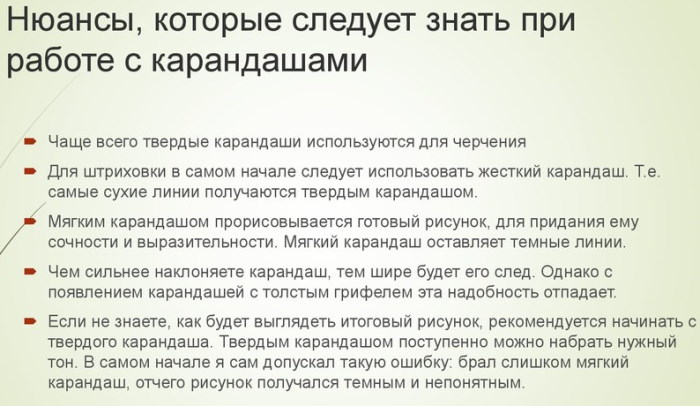
Depending on the shape, pencils have the following purposes:
- Hexagonal instruments are commonly used for writing. They have well-defined edges to make it easy for your fingers to grip and prevent slipping. However, the hard body is not ideal for writing with pressure, and the sharp edges often cause blisters.
- Semi-hexagonal pencils are often used for drawing and sometimes for writing. They have rounder edges than hexagonal pencils, so they are less hard. However, holding such pencils with your fingers is not as comfortable, especially when writing for a long time.
- Rounded edges are most often used for advertising or souvenir items, since it is easier to print a picture or text on a smooth surface, as well as for tools in a metal case. Round pencils are not very comfortable to hold in your hand for a long time, but this drawback can be corrected with a special attachment.
- Triangular pencils are best for children who are just starting to write. This shape helps them quickly learn to hold the tool correctly. Large pencils are easiest for children to use, but larger sizes are better for making random marks or large shapes than for drawing fine details.
The hardness of the pencil lead is the second most important criterion for selection. It is indicated on the body of the tool in the form of marking according to one of three established standards (USA, European countries and Russia). The decoding in any case will mean one of the available types of hardness (hard, hard-soft, soft), sometimes with an additional indication of the depth of the black tone.
Classification depending on marking
As a long-standing writing instrument, the pencil has evolved significantly and today there are different types of products, classified by material of manufacture:
- Graphite — standard everyday pencils with clay and graphite leads and a wooden body. They have many color intensity options, which are achieved using different ratios of the constituent components.
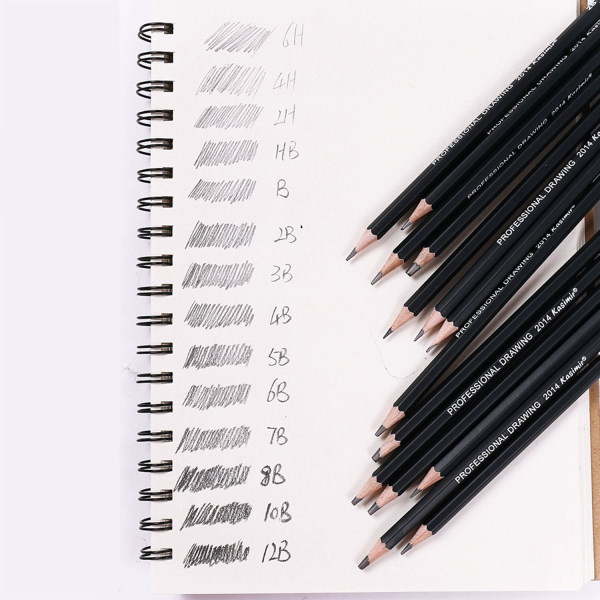
- Hard graphite pencils (woodless pencils) – tools similar to standard graphite tools, but without a wooden body. They are used for drawing, as they allow for a fast, continuous coating over a large area, and also have many levels of color depth.
- Coal – stick-shaped pencils made from charcoal and used in art. They are usually black (and darker than graphite), but there are also sepia and white shades.
- Carbon – products made from a mixture of clay and lamp black (black pigment). Their darkness changes when mixed with charcoal or graphite. But in any variety they are darker than graphite and more regular in shape than charcoal.
- Crayons – tools with a wax-based core, to which pigments with additives and binders are added. Their body is usually wooden, like standard graphite pencils. Crayons are used in fine art, and by small children – for writing, since they are easy to use and do not crumble when pressed.
Colored
Colored pencils are writing and drawing instruments whose lead consists of colored pastels, charcoal, chalk, or other material mixed with dye. They are most often used for drawing and coloring by both children and adults, including in some professional fields (architectural design).
Colored pencils are easy to use, non-toxic, and available in a wide range of shades. Unlike graphite and charcoal pencils, colored pencil leads are made from wax or oil with varying amounts of pigments, additives, and binders. Water-soluble (watercolor) and pastel pencil leads are also available, as are colored pencil leads for mechanical pencils.
Among the available pencil colors, white stands out. It is suitable for drawing on a dark background, or it is used to lighten dark tones or add shadow to the drawing being created.
Lubricants
A grease pencil is a wax writing instrument, also known as a porcelain marker, made from hardened colored wax that can be used to make marks on hard, glossy, non-porous materials.
Suitable surfaces for its application include porcelain, glass, marble, polished stone, plastic, ceramics and other glazed, varnished or polished surfaces and metal, as well as glossy paper used for photographic printing, X-rays and analog films in audio and video cassettes.
Because of its ability to write on glass, grease pencils are often used in chemistry labs to mark glassware. They are also used to mark spotlights for theater lighting. They are also popular as a marking tool in construction and renovation work because they rarely scratch surfaces when written on.
With unique properties
In addition to the various compositions and colors of the leads, pencils can have specific properties:
- Copying or indelible pencils are pencils whose lead contains a dye that allows it to be used for writing like regular graphite. But if the inscriptions or drawings made with it are wetted with water, they become sticky and smearable, which allows them to be copied onto another sheet of paper with light pressure (similar to hand printing).
- Erasable colored pencils - the drawings and writings made with them can be erased (unlike wax-based products). They are used for sketching and animation.
- Non-copyable or "non-photo blue pencils" are tools that cannot be copied on photocopiers. Today, they are used to draw sketches that will later be scanned and edited to grayscale, which will remove the blue tint.
- The stenographer's pencil is a very reliable instrument with a lead that is resistant to breakage and damage.
- Plastic - invented by Harold Grossman in the late 1960s, they are made by co-extruding a mixture of plasticized graphite and a wood-composite core of ABS plastic, wood flour, and aluminum stearate. They are very flexible - they do not break even when bent almost in half.
Advanced Species
In addition to the classic form (a stylus placed in the middle of a solid body), today you can also find improved designs on sale:
- Mechanical pencils — instruments equipped with a mechanism for pushing the lead through a hole at the end. They use special leads of varying hardness, the thickness of which corresponds to the diameter of the inner part of the body. The products are used for writing and technical drawing.
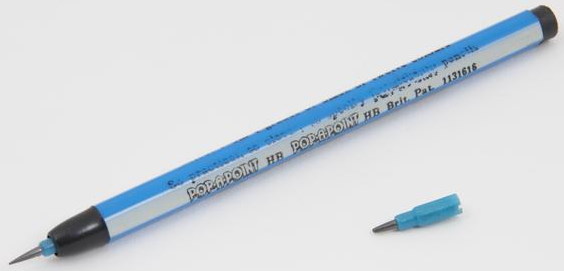
- Pop a Point Pencils – tools with multiple short stylus-tips placed in a plastic holder in the form of a cartridge. As soon as the working tip loses its shape during use, it is removed from the front and inserted into the back of the device. This pushes forward the unused replacement components, one of which ends up on the outside in place of the removed one.
Classification by hardness and softness
The hardness of a pencil lead, the meaning of which is very easy to decipher, is indicated in the form of a letter or alphanumeric marking on the body of the product (on the side surface or on the tip). Modern graphite writing instruments are classified as hard, hard-soft and soft.
- Hard pencils leave lighter marks because even with heavy pressure, little material is expended. These tools resist rubbing and smudging, and produce clean, fine lines, making them a great choice for outlines or technical drawings.
- Hard-soft types of pencils allow you to draw sharper and darker lines, the intensity and thickness of which can be varied by pressing. These are universal tools, suitable for writing, drawing and painting, since the tendency to smear and form dots is small, and the resulting strokes are very clear and thin (if done without increased pressure).
- The soft type of tool offers a much wider range of possibilities, mainly for drawing. The created strokes are thick and have a deep, dark color, the intensity of which is easily adjusted by pressure. Since soft pencils tend to smudge and create dotted spots around the drawing, they are not recommended for drawings and projects with clear details and straight lines.
Marking and classification
The hardness of a pencil lead, the decoding of which is unclear to many, is actually the main characteristic of the tool. The confusion arises due to the simultaneous use of three marking standards - Russian, European and American. It is necessary to understand the values of each scale in order to then easily compare them with each other.
Numerical scale
In the US, pencil manufacturers use a numerical scale. Its values are based on numbers indicating the level of hardness of the graphite lead. The higher the number, the harder the pencil and the lighter its stroke will be. There are 5 values in total, one of which is represented by a fraction (1, 2, 2½, 3 and 4).
Marking No. 1 indicates soft lead, No. 2 – hard-soft, No. 2½ – hard-soft thin, No. 3 – hard, No. 4 – ultra-hard.
HB scale
Most pencil manufacturers in Europe use the HB grading system. It consists of three letter markings - H, B and F. However, they are often accompanied by a number indicating the level of hardness, intensity of black tone or thinness.
The decoding of the main values is as follows:
- The letter H indicates hardness. Pencils with this marking are extremely resistant to smudging and allow you to get clear, thin lines. The color of the inscription or drawing will be quite light, without pronounced blackness. However, if you press too hard, you can damage the paper or leave deep scratches.
- HB marking used to indicate medium hardness. This is the most common type of hard-soft pencils used for writing, since the lead leaves quite dark lines, and the inscriptions made are easy to read. When the pressure is reduced, the color noticeably fades, which allows you to independently alternate the depth of the dark tone without applying serious effort. Plus, the density of the pencil is quite high, so smudging rarely occurs.
- F-marked pencils are a slightly lighter version of HB. Like standard hard-soft pencils, they are capable of producing different depths of dark tone, but without any extremes. The graphite material contained in F-marked pencils is slightly harder than HB, meaning that it can stay sharp for a longer period of use. The literal meaning of F-marking is “fine.”
- Class B refers to a soft type of pencil that leaves thick, dark strokes. These tools are used for writing, but mostly for drawing. The lines drawn spread easily, but they are not difficult to erase. By controlling the pressure and tilt of the pencil, you can control the depth of tone almost at the same level as a brush.
In addition to letter hardness designations, the European scale also uses numerical markings. They indicate the depth of the dark tone and the specific shade of the lead.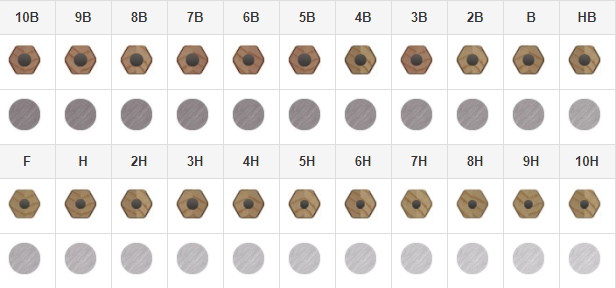
This marking applies to classes H and B:
| Hardness | Hardness + color depth | Peculiarities |
| B | 8B | Provides the darkest shade of gray on any material. Considered ideal for drawing and sketching as it creates noticeable, dark and thick strokes. |
| 7B | Suitable for art-related work. The shade of this type of pencil is dark gray, and its intensity is slightly less compared to 8B. When used on paper, it produces a clear, bright image, complemented by extremely dark elements. | |
| 6B | It is considered the best for drawing, as it is capable of creating several different dark shades, especially on paper. When creating portraits, it allows you to get Realistic textures that accurately convey the characteristics of skin, fabric and fur. | |
| 5B
| Makes medium-dark marks on paper and is used in a variety of applications, the most common of which are drawing and sketching. | |
| 4B | A little lighter and more variable with shades of gray, ideal for sketching and drawing. The light nature of this type of pencil allows you to apply less pressure when working with paper and still create three-dimensional images. | |
| 3B | Light shades prevail over darker ones. Strokes, applied to paper, have a distinct light gray color. Used to create light and shadow effects in drawings. | |
| 2B
| These pencils produce a good range of tones and shades on paper, making them ideal for a variety of uses. The strokes can range from medium to dark grey, and can vary depending on the pressure applied. They are used for drawing, sketching and shading. | |
| H | 2H | 2H pencils are very light in color. They are also made from a large amount of clay, which allows for very light strokes and does not even leave marks on paper. They are ideal for drawing and engineering work. |
| 3H | Leaves light shades of gray on the paper. This type of pencil is great for sketches that involve adding light shades, as well as for coloring individual parts of a drawing or project. | |
| 4H | Type 4H is a great option for artists who want a reflective pencil that can draw fine lines and create shading in their drawings. The strokes produced are closer to a medium gray tone, which appears less shiny. These pencils can be used for a variety of purposes, including sketching. | |
| 5H
| Creates fairly dark and thin lines. 5H pencils guarantee satisfactory results for any activity that requires drawing with thin and noticeable color strokes. | |
| 6H | High-quality graphite pencils, commonly used for drawing, sketching and writing, as well as other artistic and technical work. It has the highest level of hardness of all pencil types and provides the darkest and finest marks on paper. |
TM scale
In Russia and the countries of the former USSR, a letter marking with three values is used:
- T – hard;
- TM – hard-soft;
- M – soft.
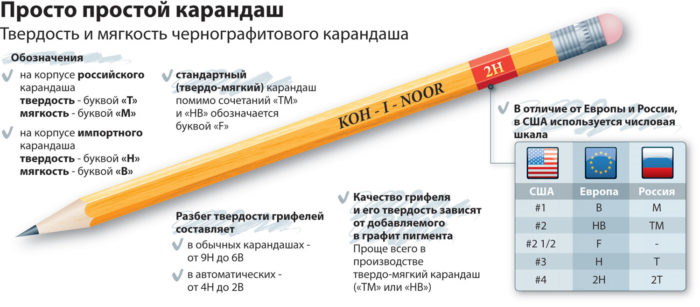
Unlike the European standard, additional characteristics and subtypes are not distinguished. The classification concerns only the degree of hardness of the lead, while the color features do not have any designations (including the depth of the dark tone and the variability of shades).
Comparison of values of different scales
Pencil lead hardness, the decoding of which is similar in different rating scales, is divided into 3 main types - soft, hard and medium (hard-soft). The remaining classes and types, even when using separate markings, are actually their subtypes.
The relationship between values from different rating scales can be represented as follows:
| Hardness (+ color depth) / scale | European | Russian | American |
| soft | B | M | 1 |
| hard-soft | HB | TM | 2 |
| hard-soft sharp | F | 2 ½ | |
| solid | H | T | 3 |
| hard light | 2H | 4 |
How to determine the hardness and softness of pencils
If the marking on the body of the pencil is missing or damaged, its hardness can be determined in several ways. The most accurate and error-free is to use a special tester tool. If it is not available, you can determine the type of pencil using improvised means, but the result will not be very accurate.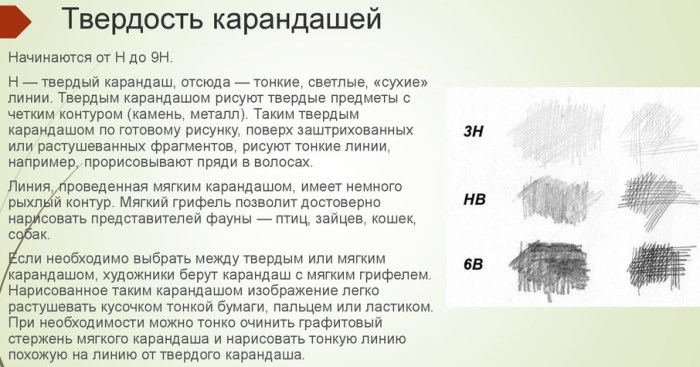
The simplest method is to draw a square or any other small figure with each of the pencils being tested and color it uniformly. If the drawings are light and rather dull, the lead is most likely hard; if the figures are dark and bright, with a striking shade, it is most likely a soft instrument.
Another home method is to place sharpened pencils at a 45-degree angle to the paper and draw a few strokes with each of them. Thin, clear and light lines are formed by hard pencils, thick, slightly blurred and dark ones - by soft ones.
Although the pencil lead hardness deciphering is similar across different markings, the standards used are very arbitrary. Therefore, identical markings from different manufacturers often do not guarantee that the pencils will be completely identical.
Video about drawing pencils
Marking of drawing pencils:
